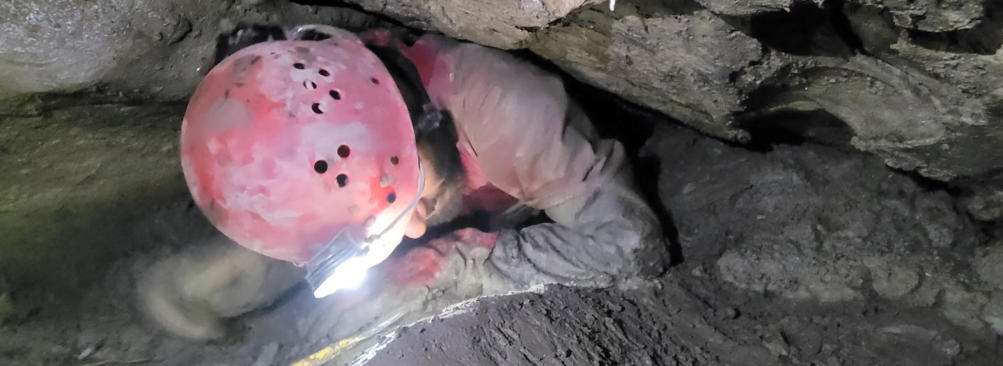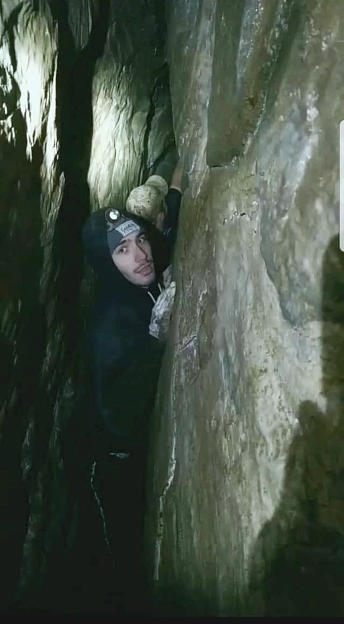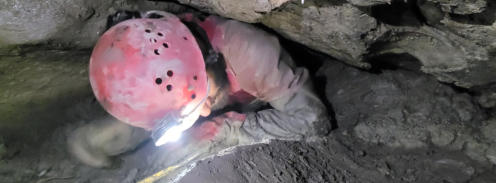


© 2025 SpeleoCanada

Safety
Caving can be done safely with appropriate measures to
assess and mitigate the inherent risks in the cave
environment and its approaches. As with any outdoor
adventure sport, it’s a matter of preparation, training,
experience, equipment, situational awareness and
caution. No matter how large or small the cave, how
well known it is, or how experienced you are:
•
Rule #1: Never go caving alone; and always stay with
your group.
•
Rule #2: Always let someone back home know
where you are going, and when you expect to return.
Then check back when you get out! (If you follow
rules #1 and 3 you should be able to allow plenty of
time and avoid an unnecessary rescue callout.)
•
Rule #3: Plan your trip carefully, including looking at
available surveys and trail information to minimize
the risk of getting lost, and ensuring that you and
your companions have proper equipment and skills
training for the nature of the trip. Is the cave gated
and if so, can you get in and out?
•
Rule #4: Monitor yourself and your companions as
you progress, to avoid becoming overtired or
hypothermic. Do not hesitate to turn back if issues
arise; too many wilderness incidents have resulted
from “pushing” a goal.
Injuries in caves are rare, but even minor ones can be
fatal if the victim is so far underground or in such a
constricted position that companions cannot extricate
the individual from the cave in time. Most caves in
Canada are fairly cold year - round, and an injured
person can quickly lapse into unconsciousness from
hypothermia.
We highly recommend training in wilderness first aid
and small-group self-rescue, as it will typically take a
long time for large – scale cave rescue resources to
arrive.
Typical caving dangers include being hit by falling rocks
(usually loosened by cavers climbing above the victim),
slipping on muddy surfaces, equipment failures, athletic
injuries such as a sprained ankle, getting confused or
lost, hypothermia and exhaustion. Simply put: approach
this sport very cautiously. Even if a cave initially appears
to be quite easy to visit, it is important to be properly
equipped and aware of your own limitations, and the
limitations of other members of your group. Instruction
and mentorship is highly recommended.
An underground injury could result in an extremely
difficult and expensive rescue. A serious accident
requiring help should be reported to the local agency
with jurisdiction (usually the RCMP, although it may be
Parks Canada or other agencies depending on location),
who will contact whatever resources might be available
in the area and potentially issue a tasking to an
organized rescue group such as the Alberta/BC Cave
Rescue Service.
There are numerous additional sources of good
information on caving safety on-line including relevant
web pages of the National Speleological Society [Add
hot link] in the United States. More advanced ‘technical’
safety and rescue techniques are available in numerous
books and on-line sources, although there is clearly no
substitute for experiential training with qualified
instructors.
A Word About Liability
Caving is similar to many other wilderness adventure
activities in that it can be done safely with proper
training, equipment and prudent behaviour, but there
are inherent risks which can never be totally eliminated.
Speleo Canada and all of its associated organizations
make no assurances or warranties, explicit or implicit,
that any individual will be free from harm, either on a
trip organized by an affiliated group or on a self-
organized trip involving individual cavers. We believe
that safety is the responsibility of each individual caver
within their underground team, and that in the event of
an accident it is the individuals involved who are
responsible for their actions and any costs associated
with a rescue attempt. It is a requirement of all
provincial caving groups that their members execute a
legal liability waiver which incorporates this principle.
CAVE or KARST PICTURE


Speleo Canada

Franck Tuot - BC


Mike Radcliffe - New Brunswick



© SpeleoCanada 2024
Safety
Caving can be done safely with appropriate
measures to assess and mitigate the inherent
risks in the cave environment and its
approaches. As with any outdoor adventure
sport, it’s a matter of preparation, training,
experience, equipment, situational awareness
and caution. No matter how large or small the
cave, how well known it is, or how
experienced you are:
•
Rule #1: Never go caving alone; and always
stay with your group.
•
Rule #2: Always let someone back home
know where you are going, and when you
expect to return. Then check back when
you get out! (If you follow rules #1 and 3
you should be able to allow plenty of time
and avoid an unnecessary rescue callout.)
•
Rule #3: Plan your trip carefully, including
looking at available surveys and trail
information to minimize the risk of getting
lost, and ensuring that you and your
companions have proper equipment and
skills training for the nature of the trip. Is
the cave gated and if so, can you get in
and out?
•
Rule #4: Monitor yourself and your
companions as you progress, to avoid
becoming overtired or hypothermic. Do
not hesitate to turn back if issues arise; too
many wilderness incidents have resulted
from “pushing” a goal.
Injuries in caves are rare, but even minor ones
can be fatal if
the victim is so
far underground
or in such a
constricted
position that
companions
cannot extricate
the individual
from the cave in
time. Most caves
in Canada are fairly cold year - round, and an
injured person can quickly lapse into
unconsciousness from hypothermia.
We highly recommend training in wilderness
first aid and small-group self-rescue, as it will
typically take a long time for large – scale
cave rescue resources to arrive.
Typical caving dangers include being hit by
falling rocks (usually loosened by cavers
climbing above the victim), slipping on
muddy surfaces, equipment failures, athletic
injuries such as a sprained ankle, getting
confused or lost, hypothermia and
exhaustion. Simply put: approach this sport
very cautiously. Even if a cave initially appears
to be quite easy to visit, it is important to be
properly equipped and aware of your own
limitations, and the limitations of other
members of your group. Instruction and
mentorship is highly recommended.
An underground injury could result in an
extremely difficult and expensive rescue. A
serious accident requiring help should be
reported to the local agency with jurisdiction
(usually the RCMP, although it may be Parks
Canada or other agencies depending on
location), who will contact whatever
resources might be available in the area and
potentially issue a tasking to an organized
rescue group such as the Alberta/BC Cave
Rescue Service.
There are numerous additional sources of
good information on caving safety on-line
including relevant web pages of the National
Speleological Society [Add hot link] in the
United States. More advanced ‘technical’
safety and rescue techniques are available in
numerous books and on-line sources,
although there is clearly no substitute for
experiential training with qualified
instructors.
A Word About
Liability
Caving is similar to many other wilderness
adventure activities in that it can be done
safely with proper training, equipment and
prudent behaviour, but there are inherent
risks which can never be totally eliminated.
Speleo Canada and all of its associated
organizations make no assurances or
warranties, explicit or implicit, that any
individual will be free from harm, either on a
trip organized by an affiliated group or on a
self-organized trip involving individual cavers.
We believe that safety is the responsibility of
each individual caver within their
underground team, and that in the event of
an accident it is the individuals involved who
are responsible for their actions and any costs
associated with a rescue attempt. It is a
requirement of all provincial caving groups
that their members execute a legal liability
waiver which incorporates this principle.


Speleo Canada





















